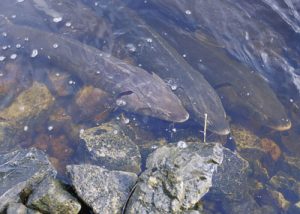
The Michigan Department of Natural Resources (DNR) is seeking the public’s assistance in gathering information on lake sturgeon.
Those who have seen a lake sturgeon in the wild can provide details on their sighting via the Lake Sturgeon DNR Reporting Page found at michigan.gov/sturgeon.
The reports allow Michigan DNR to learn more about populations of lake sturgeon that exist throughout the state, especially those smaller populations about which the department may have little information.
Lake sturgeon are Michigan’s largest fish species and are one of the most awe-inspiring species found in the Great Lakes and select inland waters.
Once abundant, lake sturgeon populations were decimated by over-fishing and habitat destruction in the late 1800s. These fish were largely forgotten until recent decades when a renewed interest and desire for rehabilitation began to occur.
Lake sturgeon can grow to weigh more than 200 pounds and measure 7 feet long. Their typical life span is 55 years for males and 70 to 100 years for females.
Michigan has strong populations of lake sturgeon in limited areas, such as the Sturgeon and Menominee rivers in the Upper Peninsula, Black Lake (Cheboygan County), the St. Clair River, and the Detroit River.
There also are smaller, recovering populations in other areas, including the St. Marys, Manistee, Muskegon, Grand and Kalamazoo rivers, as well as Burt and Mullett lakes (Cheboygan County).
Lake sturgeon rehabilitation in Michigan is a collaborative effort. State, federal and tribal agencies have partnered with each other and many citizen-led interest groups to help improve habitat, provide protection through regulations, and provide funding for research and hatchery production of juvenile sturgeon for stocking.
source: Michigan Department of Natural Resources